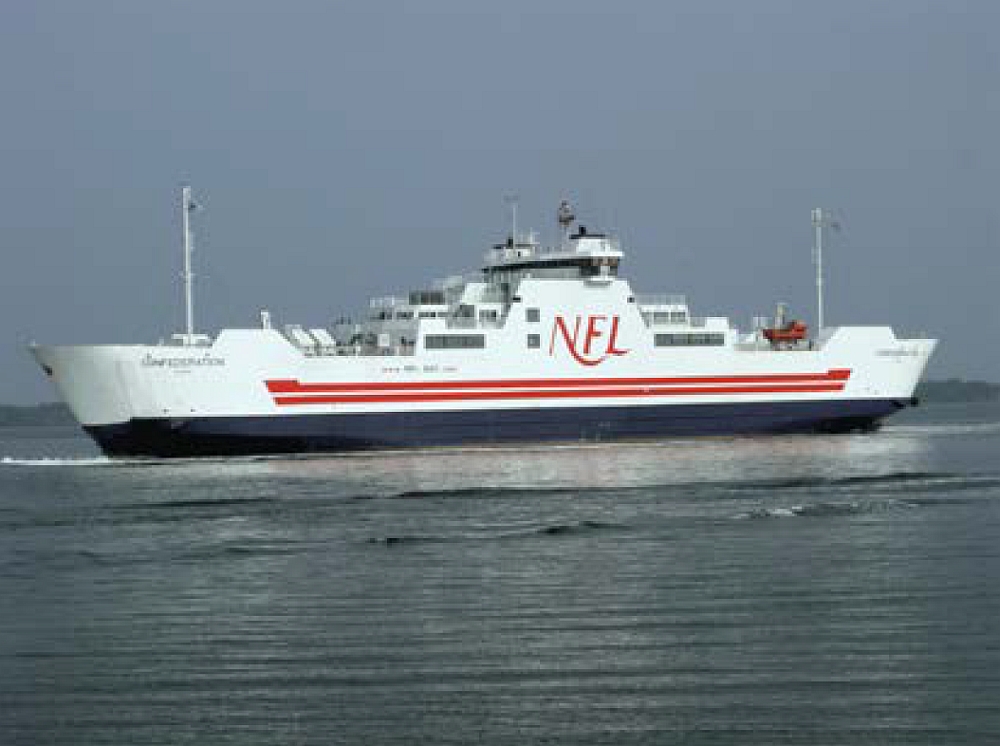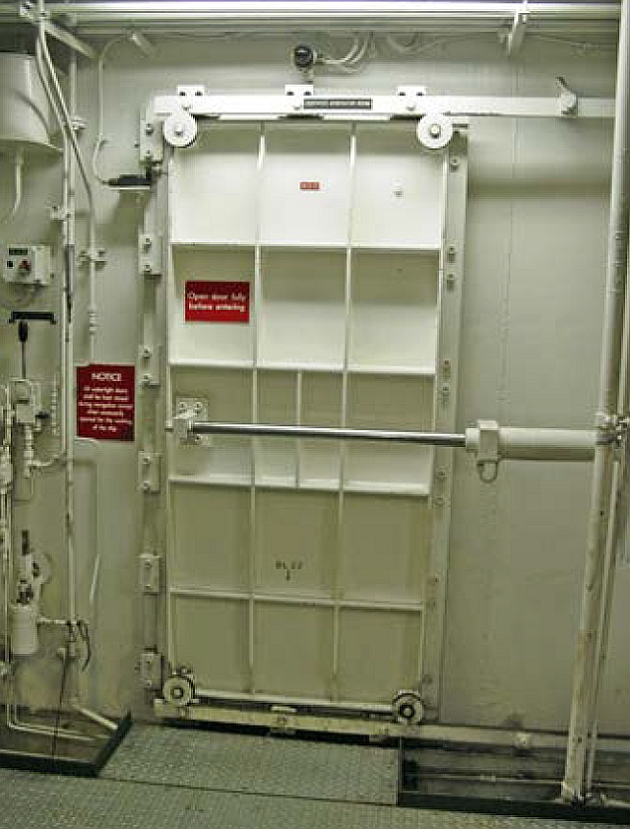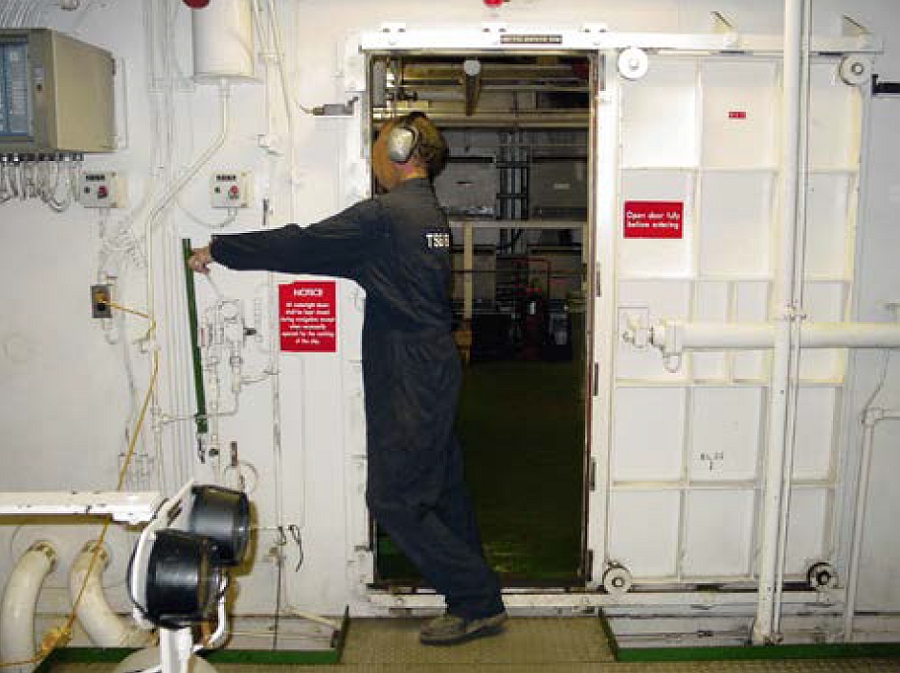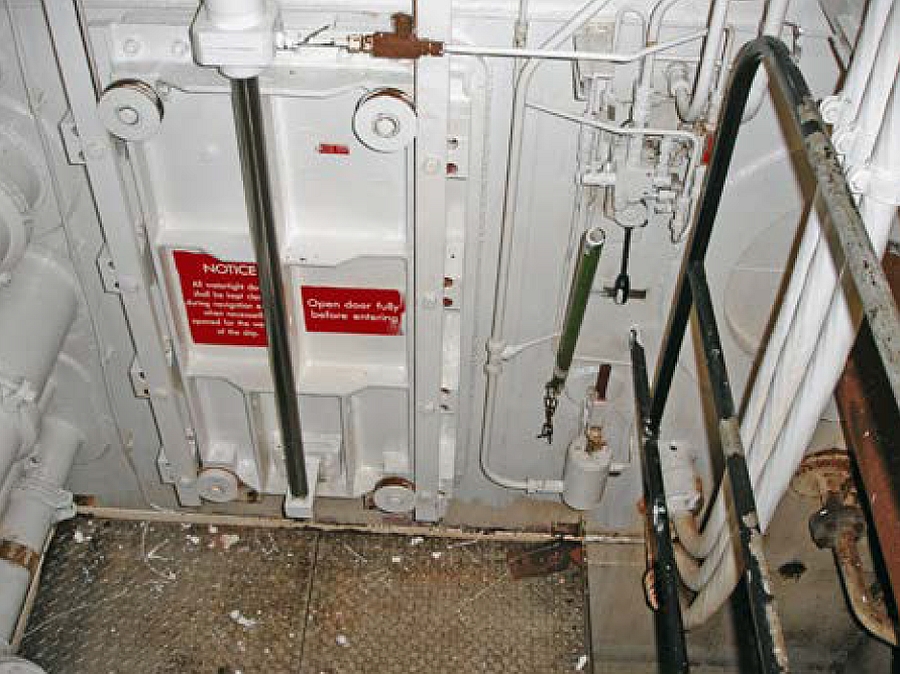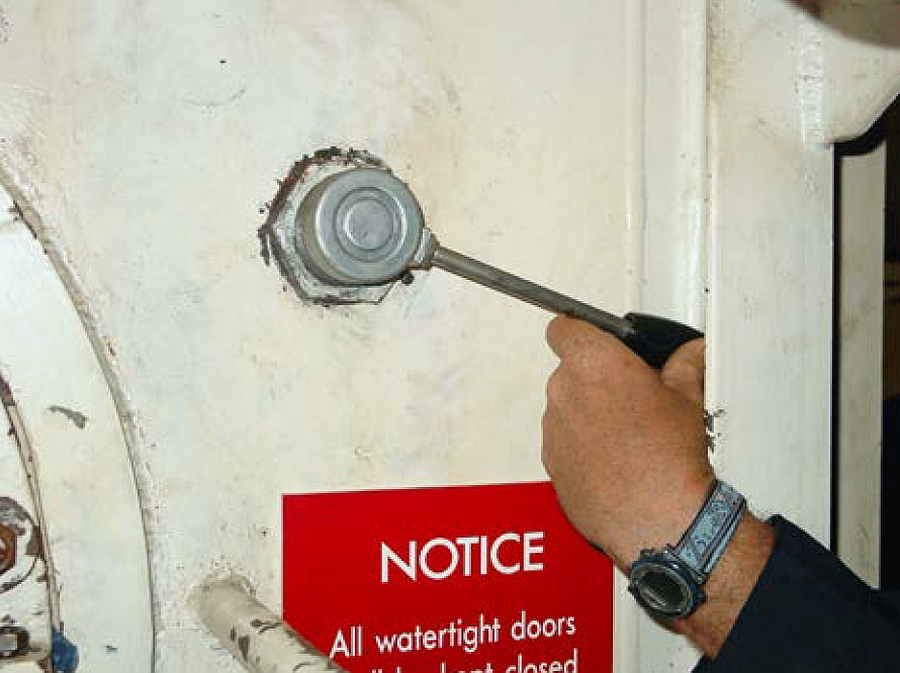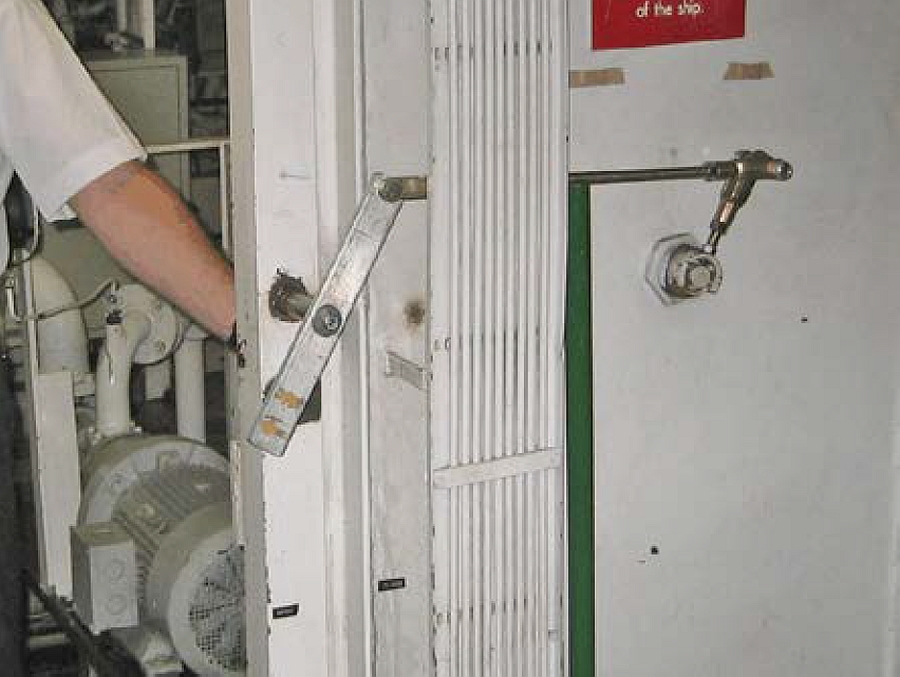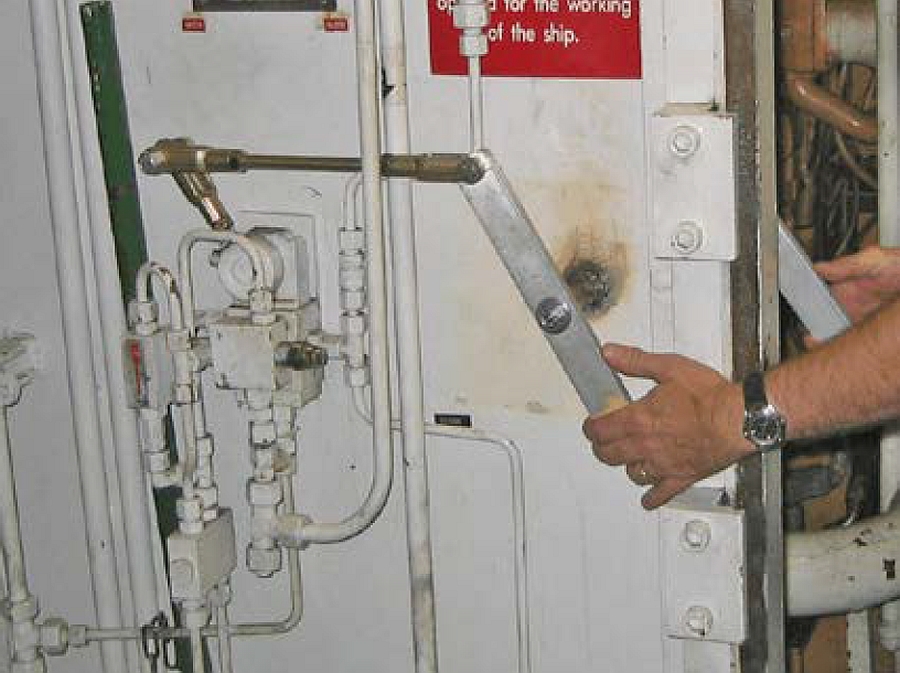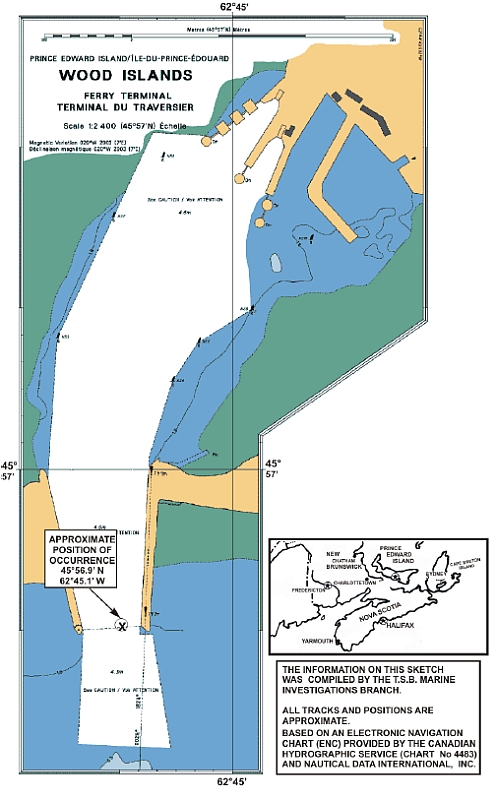Serious injury
Ro-Ro passenger ferry Confederation
Wood Islands, Prince Edward Island
The Transportation Safety Board of Canada (TSB) investigated this occurrence for the purpose of advancing transportation safety. It is not the function of the Board to assign fault or determine civil or criminal liability. This report is not created for use in the context of legal, disciplinary or other proceedings. See Ownership and use of content. Masculine pronouns and position titles may be used to signify all genders to comply with the Canadian Transportation Accident Investigation and Safety Board Act (S.C. 1989, c. 3).
Summary
On the afternoon of 27 June 2005, the ro-ro passenger ferry Confederation with 114 passengers on board departed Caribou, Nova Scotia, for Wood Islands, Prince Edward Island. The voyage was uneventful until the vessel was making preparations to dock at Wood Islands, when a crew member was discovered trapped in a watertight door. The crew member was quickly freed from the door and subsequently transported to hospital for treatment.
Ce rapport est également disponible en français.
Factual information
Particulars of the vessel
| Name of vessel | Confederation |
|---|---|
| Official number | 815540 |
| Port of registry | Ottawa |
| Flag | Canada |
| Type | Ro-Ro passenger ferry |
| Gross tonsFootnote 1 | 8060.8 |
| Length | 96.01 m |
| Draught | Forward: 3.91 m Aft: 3.98 m |
| Built | 1993, Pictou Industries Limited |
| Propulsion | Wärtsilä Wichmann, 6000 kW, 2 controllable pitch propellers (1 forward, 1 aft) |
| Cargo | 43 private motor vehicles, 5 commercial vehicles |
| Crew members | 23 |
| Passengers | 91 |
| Operator | Northumberland Ferries Limited Charlottetown, Prince Edward Island |
| Owner | The Minister of Transport Ottawa, Ontario |
Description of the vessel
The Confederation was built in 1993 as a double-ended, roll-on roll-off (ro-ro) ferry to transport passengers and vehicular traffic between Nova Scotia and Prince Edward Island (PEI). The vessel has three vehicle cargo areas on decks A, B and C, with passenger facilities on decks D and E. The vessel has the capacity to carry 600 passengers and 215 private motor vehicles.
History of the voyage
At approximately 1620 Atlantic daylight timeFootnote 2 on 27 June 2005, the ro-ro passenger ferry Confederation departed Caribou, Nova Scotia, on its final crossing of the day for Wood Islands, P.E.I. The winds were reported to be from the east at 10 knots with rippled seas. Two members of the engine room crew were carrying out maintenance to a piece of equipment in the engine room. Shortly before the vessel was due to arrive at the ferry terminal, one of the crew members left the engine room to retrieve a part to complete the job.
At approximately 1727, the crew member was noticed caught in a horizontal sliding watertight door by his co-worker. The co-worker immediately opened the door, freeing the unconscious crew member. He carefully lowered him to the deck and made him comfortable. Shortly afterwards, the crew member regained consciousness. The vessel continued on to the Wood Islands ferry terminal, arriving five minutes later, where the crew member was treated and transported to hospital by ambulance.
There was no observer to the occurrence and the exact circumstances leading up to the occurrence could not be determined. Occasionally, crew members would open the door only as far as was required to allow passage, and they did not always hold either or both operating lever(s) after opening the door.
Watertight doors
The Confederation is equipped with three electro-hydraulic watertight doors. Two of the doors are vertical sliding and isolate the two propulsion gear rooms from their respective shaft tunnels, while a third horizontal sliding door isolates the generator room from the engine room. All three doors are capable of being closed from a central location on the bridge and can also be operated locally.
Whenever the vessel is in transit, all three watertight doors are controlled and closed automatically from a central location on the bridge. The doors may still be operated locally, but the door will only stay open for as long as the local operating lever is held in the open position. When the lever is released, the door will close.
The doors are typically operated in the manual mode when the vessel is secured alongside. In this mode, the doors are opened and closed locally by actuating the operating lever; but when the lever is released, the door movement stops and it remains in that position, at the point the lever was released.
It is the practised policy of Northumberland Ferries Limited that the watertight doors be closed from the central location on the bridge whenever the vessel is at sea. This policy is addressed in the vessel's training manual as well as on signage posted at each of the three watertight doors. Additionally, warning signs are posted at each watertight door, instructing "Open door fully before entering."
Regulations – Watertight doors
Regulations pertaining to the construction, installation and operation of watertight doors are contained within the Hull Construction Regulations of the Canada Shipping Act. A section that applies to the installation of watertight doors reads in part:
… handles for controlling the power system shall be provided at both sides of the bulkhead in which the door is situated and shall be so arranged that any person passing through the doorway will be able to hold both handles in the open position simultaneously …Footnote 3
Post-occurrence trials on the Confederation showed that for all three sliding watertight door installations, it was very difficult to hold both operating levers at the same time. In the case of the horizontal sliding watertight door, the axis of rotation for the operating lever was approximately 51 cm from the edge of the door, and it had a 13 cm throw. This required the operator of the door to have a reach of approximately 64 cm (see photo 3).
In the case of the two vertical sliding watertight doors, the axis of rotation for the operating levers was 37 cm and was, therefore, closer to the edge of the door. However, access to the operating levers on one side of both doors was restricted by an angle frame (see photo 6). Additionally, the lever operation of the two doors was not consistent. In one case, the door was opened by pushing the lever, while in the second case the lever was pulled.
Watertight door operational requirements/guidance
The service instructions for the watertight door involved in the occurrence indicated that the door must close from fully opened to fully closed in a minimum of 20 seconds and a maximum of 40 seconds. The manufacturer's specification is similar to the Safety of Life at Sea (SOLAS)Footnote 4 regulations. The SOLAS regulations do not, however, apply to Canadian non-convention passenger vessels such as the Confederation.
There are no Canadian regulations that govern the minimum and maximum closing times for sliding watertight doors, and guidance provided by the manufacturer and SOLAS was not used to determine the safe operational parameters of the watertight door.
Post-occurrence watertight door trials
The afternoon following the occurrence, watertight door opening and closing time trials were conducted by the Transportation Safety Board and Transport Canada (TC). The following operating times were observedFootnote 5.
| Sliding watertight door | Time to attain fully opened from fully closed | Time to attain fully closed from fully opened |
|---|---|---|
| Forward – Vertical | 16 to 17 seconds | 30 seconds |
| Aft – Vertical | 12 to 13 seconds | 22 to 24 seconds |
| Centre – Horizontal | 12 to 13 seconds | 10 to 13 seconds |
Vessel certification
The Confederation is subject to regular inspection by TC as a non-conventionFootnote 6 passenger ship, and it was last issued a Safety Inspection Certificate on 06 June 2005. The vessel also maintains a Lloyds Register Class ✠100A1, ✠LMC UMS.
Personnel certification
The master and officers of the Confederation held certificates valid for the class of vessel and the type of voyage being undertaken. Furthermore, all of the officers and crew had Marine Emergency Duties training, which is consistent with TC's requirements, according to the position they held on board the ship.
Personnel history
The injured crew member had 30 years of service at sea and 10 years on board the Confederation. He had been certificated as a marine engineer since 1979.
Injuries to persons
The crew member trapped in the watertight door suffered major crush-related injuries and was hospitalized.
Findings
Findings as to causes and contributing factors
- The exact circumstances leading up to the occurrence could not be determined.
- The horizontal sliding watertight door was not being operated in accordance with the manufacturer's specifications for minimum closing time.
Findings as to risk
- The practice of not fully opening the watertight door before attempting to pass through it increases the risk of a personal accident.
- The relatively quick closing time for the watertight door subjects the transient to undue risk.
- The location of the operating levers for the three local watertight door stations was less than optimal, and the operation of the levers to open and close the doors was not consistent among all three doors.
- There is no Canadian regulation that addresses the minimum and maximum closing times for sliding watertight doors, and the guidance provided in SOLAS and by the manufacturer was not used to determine the safe operational parameters of the watertight doors.
Other findings
- Weather and sea conditions were favourable and there was no weather-related motion of the vessel.
Safety action
Action taken
Transportation Safety Board of Canada
In August 2005, the Transportation Safety Board (TSB) issued a Marine Safety Information (MSI) letter (No. 02/05) addressed to Transport Canada (TC) with a copy to Northumberland Ferries Ltd. The letter informed both parties of the TSB's observations regarding the deficiencies associated with the installation and operation of the watertight door system onboard the Confederation. The observations included:
- the relatively quick closing time for the watertight door;
- the less than optimal location of the operating lever on all three local watertight doors;
- the fact that the operation of the levers to open/close watertight doors was not consistent among all three doors;
- the fact that Canadian regulations do not address the minimum and maximum closing times for sliding watertight doors, and
- the practice of not fully opening the watertight door before attempting to pass through it.
Northumberland Ferries Limited
Following the occurrence, the time required for the horizontal watertight door to close from fully opened was adjusted to 26 to 30 seconds per the manufacturer's specifications.
The control levers for the horizontal sliding door have been modified to reduce the distance that the operator must reach. The operator can now, on both sides of the door, comfortably hold the levers in the open position while passing through the opening. Also, the door now slides in the same direction that the lever handle is moved.
A policy has been adopted to be included in the Shipboard Operations Manual, whereby all crew members who have occasion to use any watertight door must be instructed on the safe operation of those doors. This policy includes written instruction on the correct method of using watertight doors.
A procedure has been adopted for the inspection and servicing of watertight doors to ensure that they are maintained and operated as recommended by the manufacturer. Items included in this inspection are alarms, signage, and closing and opening times.
Transport Canada
TC issued Ship Safety Bulletin No. 07/1991 entitled "Accidents When Using Power Operated Watertight Doors." The bulletin was issued as a result of a similar incident that occurred on a Canadian ferry prior to May 1991 and is a reminder that all power-operated watertight doors are designed to ensure maximum safety of the ship and to persons using them.
As part of Phase 2 of Regulatory Reform, TC will be reviewing and subsequently re-drafting the Hull Construction Regulations to incorporate and/or reference many of the Safety of Life at Sea (SOLAS) regulations, thereby making them applicable to Canadian-registered domestic vessels.
The SOLAS requirements for power-operated sliding watertight doors will be referenced in the proposed new Hull Construction Regulations along with the minimum and maximum operating time parameters. TC will also consider augmenting the requirements so that issues such as obstructions in the way of the operating handles that may restrict the proper operation of the controls are also addressed.
In a response to MSI letter No. 02/05, dated 1 September 2005, TC's Atlantic Region stated that it had issued a Direction under the Canada Labour Code, Section 8.3.1, on 5 July 2005 to the captain of the Confederation. Following this, all three watertight doors were adjusted to close in the prescribed time. In the case of the horizontal watertight door, the levers were relocated to make the operation of the door easier; that is, the lever actuates the door in the same direction of travel and the handles are now very close to the door opening.
This report concludes the Transportation Safety Board's investigation into this occurrence. Consequently, the Board authorized the release of this report on .
